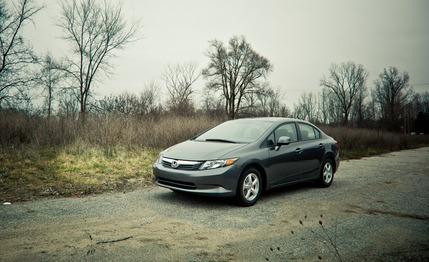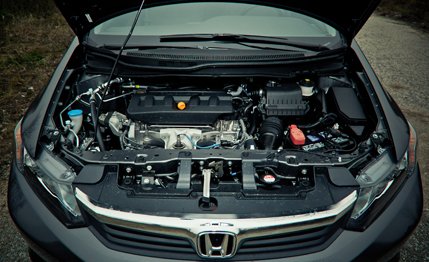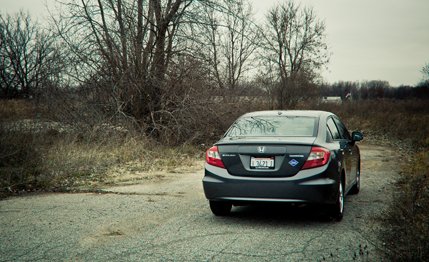 Instrumented Test
Instrumented Test

What Is It?
It’s a Honda Civic that runs on compressed natural gas (CNG). In fact, it’s the only factory-built CNG car in the country available to nonfleet customers. Exciting, right? Well, probably only if you live in one of the 36 states where the Civic CNG is now available (greatly expanded from the four states where you could buy the previous CNG Civic). But if you live where it’s sold, you might be glad to know that the EPA says almost 87 percent of the natural gas used in the U.S. is produced domestically. And it burns cleaner than gasoline.
Clean-burning domestic fuel sounds great, but there’s a catch with this Civic. Actually, there are a few. First and foremost is that the car’s supply of CNG is stored in a 3600-psi tank that sits behind the rear seats and cuts the trunk space in half, to six cubic feet. In energy equivalence, the Civic CNG holds about eight gasoline gallons’ worth of fuel. Honda lists a conservative range estimate of 220 miles. Part of the reason for the conservative promise, it explains, is that different stations refill the CNG tank differently, and ambient temperatures can affect how much you are able to fill the tank.
Running on CNG requires a few modifications to the 1.8-liter four-cylinder engine, including stronger connecting rods to handle the added stress of a 12.7:1 compression ratio (up from 10.6), new valves and valve seats that deal with CNG’s nonlubricating properties, special fuel injectors, and a pressure regulator. With all of that, the Civic CNG makes 110 hp, 30 fewer than its gasoline counterpart. Torque drops by 22 lb-ft, to 106.

How Does It Drive?
Exactly like a Civic that has lost 30 hp. Zero to 60 takes 10.7 seconds, 1.7 seconds longer than the gas-powered Civic EX and 0.6 longer than the Civic hybrid (it also has 110 hp). Keeping pace with Michigan’s 70-plus-mph highway traffic in the Civic CNG is an exercise in patience, advance planning, and luck. Pick a spot, floor the throttle, wait for the digital speed display to creep up, and hope that you judged that traffic gap correctly.
The CNG thuds over medium-size bumps and is generally harsher than the soft and comfortable gasoline-powered Civic. It’s surprising, then, that the Civic CNG is only 90 pounds heavier than the gasoline Civic and 30 pounds lighter than the Civic hybrid. As with its petrol-powered counterpart, the Civic CNG lacks steering feel and does little to excite the enthusiastic driver. Positive attributes remain, however, such as comfortable seats, ample rear-seat space (with a flat floor), and good sightlines.
The main issues with the Civic CNG, though, are range and infrastructure. We found single-tank travel distances beyond 200 miles to be possible, but that was only when we knew a filling station was close enough to exploit the lower end of the fuel gauge without worry. Our Ann Arbor office has four CNG pumps nearby, and a few more are available throughout the metro Detroit area. Filling up is fairly straightforward. You simply latch the filling hose onto the Civic’s nozzle (located in the same place as the fuel-filler neck on gas-powered Civics) and throw a lever on the automated pump. A few minutes later you’re topped off at 3600 psi. But there are large sections of Michigan without any CNG filling stations, a pattern echoed throughout the country (click here for a map). That means the Civic CNG, from a practical standpoint, can only be operated on a 200-mile tether from your local filling station (or your own pump, if you’re a fleet owner) unless you live in CNG-heavy areas such as the Eastern Seaboard or California. An added benefit to California ownership is that the CNG Civic permits access to high-occupancy vehicle lanes with the driver as the only occupant.

How Does It Stack Up? What’s the Cost?
For a car with less cargo space, less power, and less range, Honda charges $5650 more than for a similarly equipped Civic EX, or $26,925. If you want a navigation system, which includes a database of publicly accessible CNG refueling stations, the price increases by $1500. The Civic hybrid, battery pack and all, costs $2105 less than the CNG. In EPA fuel-economy terms, the CNG achieves 27 and 38 mpg (in gasoline-gallon equivalence) compared with 28/39 for the Civic LX with the five-speed automatic and 44/44 for the hybrid. We saw 32 mpg in our Civic CNG test car, an improvement of 1 mpg compared with the EPA combined figure.
In the Civic CNG’s favor is the ridiculously low price of its fuel. The national average for CNG in January 2012 (the most recent month of the EPA’s regular reports) was $2.13 per equivalent gasoline gallon. In EPA highway figures and using the most recent national average price of $3.52 per gallon for regular gasoline, the Civic LX and hybrid cost 9.0 and 8.0 cents per mile compared with just 5.6 cents per mile for the CNG. But that’s still not enough of a difference for the Civic CNG to pay for its added cost in any reasonable amount of time.
Up against the Nissan Leaf, another eco-minded car with limited range, the Civic CNG looks pretty good. It costs less, goes farther, and can be refueled in mere minutes. But like the Leaf, the Civic CNG is a car that has to be bought for a specific reason, whether that is environmental, political, or just because you want solo access to the commuter lane. On regular automotive terms, however, the Civic CNG doesn’t make much practical sense.